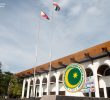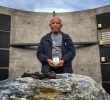WARNING: unbalanced footnote start tag short code found.
If this warning is irrelevant, please disable the syntax validation feature in the dashboard under General settings > Footnote start and end short codes > Check for balanced shortcodes.
Unbalanced start tag short code found before:
“Namfrel president Edward Go, on the other hand, had a 50 percent voter turnout estimate.) This, Tapang said, would reduce the ranking of anti-Arroyo candidates as well as the progressive Party-lists in the election results. Related”
MANILA, Philippines — The May 14 mid-term elections is one political exercise that establishes the Commission on Elections (Comelec) as a constitutional poll body whose credibility is suspect. Three years earlier, in the May 2004 presidential elections, the Comelec figured in the monumental cheating that saw Gloria M. Arroyo elected to the presidency. The electoral fraud triggered widespread calls for electoral reform starting with the revamp of the poll body. However, the calls fell on deaf ears and the alleged perpetrators of election cheating from the Comelec were not prosecuted and were even promoted, some as regional or provincial directors.
Those unresolved issues yielded what Filipinos particularly poll watch groups had anticipated: The May 14 elections would be one of the dirtiest, if not the dirtiest, electoral exercises in the Philippines’ political history. The lessons gained from the 2004 electoral fraud led to the birth of several poll watch groups with some of them, notably Kontra Daya, determined to focus on watching the Comelec itself. The proliferation of watchdogs spawned a higher consciousness among many voters all over the country on the need to safeguard the votes and to report incidents of irregularities wherever these take place.
Accounts of cheating, vote-padding and vote-shaving, vote buying, tampering with election results (ERs), fake COCs as well as incidents of election-related killings, abductions and other types of intimidation reportedly committed by military and police forces and armed goons have been received by the Center for People Empowerment in Governance (CenPEG) since Day 1 of the elections. These incidents affected the votes not only of the anti-Arroyo opposition but also the genuine Party-list groups. In turn, the irregularities greatly favored the administration candidates and government-backed Party-lists at a time when public opinion has been strongly against Mrs. Arroyo.
Based on many accounts received by CenPEG from Kontra Daya, Task Force Poll Watch (TFPW) and its provincial coordinators, the Parish Pastoral Council for Responsible Voting (PPCRV), and other poll watchdogs the possible involvement of many local election officials was conspicuous. Their accountability was evident most especially in the disenfranchisement of many voters; in spoiled ERs and in ERs and ballot boxes not counted or missing; the absence at polling precincts of lists of names of opposition senatorial candidates as well as Party-list groups particularly from the progressive bloc; in certificates of canvassing (COCs), statements of votes (SOVs) and other election forms that clearly showed widespread vote padding and vote shaving favoring administration candidates and their Party-lists.
Electoral base
Military and police meddling operations where one special project is to disenfranchise the electoral base of the progressive Party-list bloc of Bayan Muna (BM) and its allied groups, also contributed to the electoral fraud. In many provinces days before election, senior police officers enjoined election officials not to allow the Party-list groups from winning and to support instead government-backed political parties. In Bicol region, thousands of rural voters were prevented from voting. As a result, the progressive Party-list bloc lost as much as 30-40 percent of the expected votes aside from votes lost due to vote shaving and other irregularities in the region.
There were accounts of election officials allowing the entry of military and police elements inside polling places even as other poll authorities made it cumbersome for legitimate poll watchers to perform their duties. In many areas, election officials reportedly failed to investigate incidents of irregularities lodged on election day or asked poll watchdogs and aggrieved candidates to refrain from filing election protests.
This lackadaisical attitude is evident in the way Comelec chair Benjamin Abalos, Sr. has reacted to complaints of election fraud in Mindanao. Abalos asks for evidence that would prove there was large-scale cheating in Maguindanao but ignores the fact that a teacher’s confession, questionable COCs and SOVs and an affidavit of a provincial election inspector are sufficient proof for the commission to declare a failure of elections in the province.
An analyst from TFPW, UP Prof. Giovanni Tapang, estimates that votes in the ongoing Comelec canvassing may be padded by anywhere from 2 to 2.7 million votes. A check of completed city and provincial COCs from the Comelec canvass already gives a 73.4 percent voter turnout in 45 provinces, or about 4.4 percent higher than the Pulse Asia exit poll of 69 percent.
Abalos’s premature announcement that voter turnout was 75 percent provided political operators, with the complicity of election officials, with as much as 2.7 million “cheatable, negotiable votes.” ((Namfrel president Edward Go, on the other hand, had a 50 percent voter turnout estimate.) This, Tapang said, would reduce the ranking of anti-Arroyo candidates as well as the progressive Party-lists in the election results.
2007 Elections, Analysis









